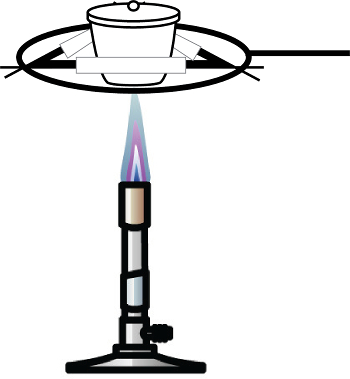Determinación de la fórmula empírica
Visión general
Fuente: Laboratorio de Dr. Neal Abrams - SUNY College de silvicultura y ciencias ambientales
Determinar la fórmula química de un compuesto está en el corazón de lo que químicos en el laboratorio todos los días. Muchas herramientas están disponibles para ayudar en esta determinación, pero uno de los más simple (y más exacta) es la determinación de la fórmula empírica. ¿Por qué es útil? Debido a la ley de conservación de la masa, cualquier reacción se puede seguir gravimétrico o por cambio de masa. La fórmula empírica proporciona el más pequeño número entero cociente entre elementos (o compuestos) dentro de un compuesto molecular. En este experimento, el Análisis gravimétrico se utilizará para determinar la fórmula empírica de hidrato del cloruro de cobre, CuxCly·nH2O.
Procedimiento
1. deshidratación de la hidratación
- Exactamente pesar una muestra de hidrato del cloruro de cobre y lo coloca en un crisol previamente secado y tarado. Es importante que el crisol se seca por encima de 120 ° C para eliminar cualquier humedad adsorbida. Por lo general, basta 1-2 g de compuesto.
- Calentar la muestra utilizando un mechero Bunsen u otra fuente de llama hasta que cambia de color de azul verdoso a un marrón rojizo (figura 1). Este cambio de color es indicativo de la forma
Resultados
- Experimento
- 1,25 g de hidrato del cloruro de cobre en un crisol de calor. Después de la calefacción y refrigeración entonces, la masa final es 0,986 g de cloruro de cobre CuxCly.
- Disolver la muestra de CuxCly en 50 mL de agua desionizada y agregue 0.2 g de aluminio fina malla en el vaso.
- Después de reaccionar y disolviendo el exceso de aluminio, 0,198 g de metal de cobre seco se recupera.
- Restar la masa del cobre y del agua de la hidratación in...
Aplicación y resumen
En un ejemplo, supongamos que un desconocido biomolécula que contiene solamente C, H, y O se encuentra actuar así como un nuevo combustible. Una forma de determinar la fórmula del combustible sería quemar lo en el aire y analizar los productos:
CxHyOz + O2 → mCO2 + nH2O
O2 es en exceso, sabemos que todo el carbono en el CO2 que se originó de las biomoléculas y el hidróge...
Saltar a...
Vídeos de esta colección:

Now Playing
Determinación de la fórmula empírica
General Chemistry
183.7K Vistas

Cristalería de laboratorio y usos comunes
General Chemistry
658.3K Vistas

Soluciones y concentraciones
General Chemistry
275.1K Vistas

Determinación de la densidad de un sólido y líquido
General Chemistry
556.8K Vistas

Determinación de la composición porcentual en masa de una solución acuosa
General Chemistry
383.8K Vistas

Determinación de las reglas de solubilidad de compuestos iónicos
General Chemistry
141.6K Vistas

Uso del medidor de pH
General Chemistry
346.7K Vistas

Introducción a la titulación
General Chemistry
425.4K Vistas

Ley del Gas ideal
General Chemistry
79.0K Vistas

Determinación espectrofotométrica de la constante de un equilibrio
General Chemistry
158.7K Vistas

Principio de le Châtelier
General Chemistry
265.8K Vistas

Depresión del punto de congelación para determinar un compuesto desconocido
General Chemistry
160.8K Vistas

Determinación de las leyes de la velocidad y el orden de la reacción
General Chemistry
196.3K Vistas

Uso de la calorimetría diferencial para medir los cambios en la entalpía
General Chemistry
44.7K Vistas

Complejos de coordinación
General Chemistry
91.7K Vistas
ACERCA DE JoVE
Copyright © 2025 MyJoVE Corporation. Todos los derechos reservados

